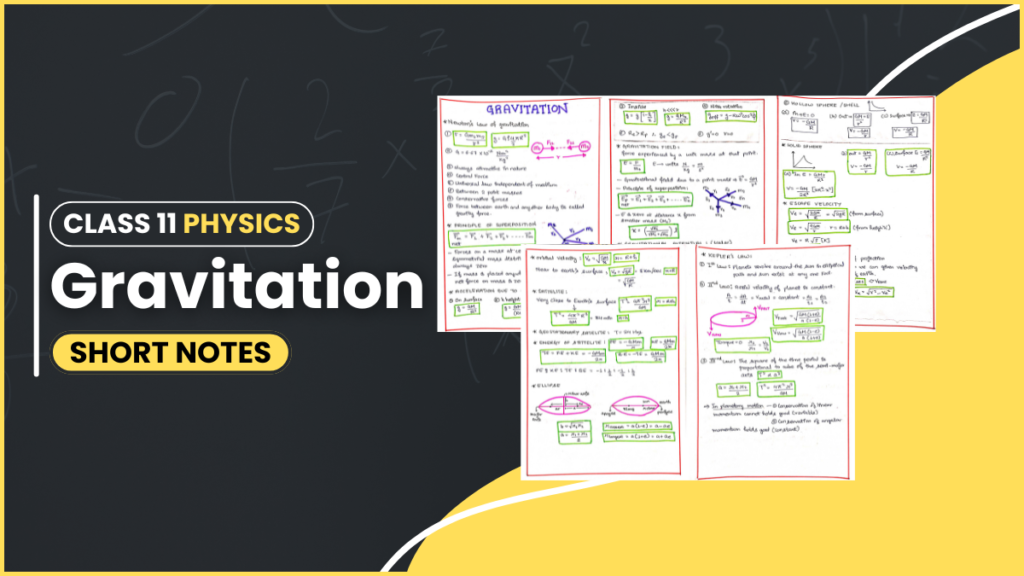Mastering Gravitation is Not That Much Tough to Crack Jee & Neet. So We Made Class 11 Physics Gravitation Topper’s Short Notes to Help you out of This. Class 11 Physics Gravitation Topper’s Short Notes are designed to give you a competitive edge by providing clear, concise, and exam-focused content.
Gravitation Topper’s Short Notes will be Helpful to Revise Important formulas With Concepts in Less time, You can Use it in You IIT JEE and Neet Exam Preparation also in Class Tests, Go Below and Download PDF!
Complete Class 11 Physics Topper’s Short Notes for IIT JEE and Neet PDF Download
Complete Physical Chemistry Short Notes PDF Download

An Important topic that you need to master in Class 11 Physics is Gravitation. This topic is fundamental to understanding the laws of physics and plays a vital role in both IIT JEE and NEET exams. To help you with this topic, we have compiled Class 11 Physics Gravitation Topper’s Short Notes in an easily downloadable PDF format.
Gravitation Short Notes
Gravitation is the force of attraction between any two masses in the universe. It is a fundamental force that causes objects to be drawn towards each other, such as planets orbiting the sun or an apple falling to the ground.
Gravitation
The force of attraction between any two masses in the universe.
Gravitational Force
The attractive force exerted by one mass on another. It is given by Newton’s Law of Universal Gravitation:
F = G (m1 m2) / r2
where F is the gravitational force, G is the gravitational constant, m1 and m2 are the masses, and r is the distance between their centers.
Gravitational Constant (G)
A universal constant with a value of approximately 6.674 × 10-11 N m2/kg2.
Gravitational Field
The region around a mass in which another mass experiences a force of gravitational attraction. The strength of the gravitational field g is given by:
g = F / m = GM / r2
where M is the mass creating the field, and r is the distance from the mass’s center.
Gravitational Potential Energy
The potential energy of a mass due to its position in a gravitational field. For a mass m at a distance r from another mass M, it is given by:
U = – GMm / r
Gravitational Potential
The gravitational potential at a point in a field is the potential energy per unit mass at that point. It is given by:
V = – GM / r
Kepler’s Laws of Planetary Motion
- First Law (Law of Orbits): Every planet moves in an elliptical orbit with the Sun at one of the two foci.
- Second Law (Law of Areas): A line segment joining a planet and the Sun sweeps out equal areas during equal intervals of time.
- Third Law (Law of Periods): The square of the orbital period of a planet is directly proportional to the cube of the semi-major axis of its orbit:
where T is the orbital period and a is the semi-major axis.
T2 ∝ a3
Escape Velocity
The minimum velocity required for an object to escape the gravitational influence of a celestial body without further propulsion. For Earth, it is approximately 11.2 km/s, given by:
ve = √(2GM / R)
where M is the mass of the Earth and R is its radius.
Orbital Velocity
The velocity needed for an object to stay in a stable orbit around a celestial body. For a circular orbit close to Earth’s surface, it is approximately 7.9 km/s, given by:
vo = √(GM / r)
where r is the radius of the orbit.
Geostationary Orbit
An orbit where a satellite remains fixed relative to a specific point on the Earth’s surface. Such orbits have a period equal to the Earth’s rotational period (24 hours) and are located approximately 35,786 km above the equator.
Satellite Motion
The movement of a satellite in orbit around a celestial body, influenced by gravitational forces.
Class 11 Physics Gravitation Topper’s Short Notes PDF Download
Downloading the notes is straightforward. Simply click at the link below and get your free PDF.



